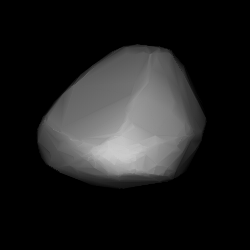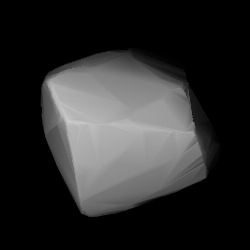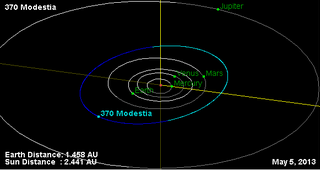
Vincentina is a fairly large main belt asteroid.
Rosalia is a large Main belt asteroid. It was discovered by Auguste Charlois on 1 September 1891 in Nice.

Gisela is an asteroid belonging to the Flora family in the Main Belt that has an unusually high albedo.

353 Ruperto-Carola is a background asteroid from the central region of the asteroid belt. It was discovered by German astronomer Max Wolf at the Heidelberg Observatory on 16 January 1893. It is named after the Ruprecht Karls University, whose Latin name is Ruperto Carola Heidelbergensis.

Gabriella is a typical Main belt asteroid.

Apolonia is a large Main belt asteroid. It was discovered by Auguste Charlois on 8 March 1893 in Nice.

Georgia is a typical Main belt asteroid. It is classified as an X-type asteroid.

360 Carlova is a very large main-belt asteroid. It is classified as a C-type asteroid and is probably composed of carbonaceous material. The asteroid has a convex, roughly ellipsoid shape. The sidereal rotation period is 6.1873 hours with an axis of rotation along the ecliptic coordinates (l, b) = (95°±3°, 40°±1°). It was discovered by Auguste Charlois on 11 March 1893 in Nice.

361 Bononia is a very large, resonant Hilda asteroid located in the outermost region of the asteroid belt. It is classified as a D-type asteroid and is probably composed of organic rich silicates, carbon and anhydrous silicates. It was discovered by Auguste Charlois on 11 March 1893, in Nice, and assigned the prov. designations A893 EF and 1893 P.

Havnia is a typical Main belt asteroid.

Amicitia is a typical Main belt asteroid that is a member of the Flora family. It was discovered by Auguste Charlois on 19 May 1893 in Nice.

Haidea is a large asteroid residing in the asteroid belt. It was discovered by Auguste Charlois on 19 May 1893 in Nice.

Modestia is probably a typical Main belt asteroid. It was discovered by Auguste Charlois on 14 July 1893 in Nice.

Bohemia is a sizeable Main belt asteroid. It was discovered by Auguste Charlois on 16 July 1893 in Nice.

373 Melusina is a large Main belt asteroid. It is classified as a C-type asteroid and is probably composed of carbonaceous material. It was discovered by Auguste Charlois on 15 September 1893 in Nice.

Burgundia is a typical main belt asteroid that was discovered by Auguste Charlois on 18 September 1893 in Nice. It was named for the former French region of Burgundy. It is one of seven of Charlois's discoveries that was expressly named by the Astromomisches Rechen-Institut.

Geometria is a main belt asteroid that was discovered by French astronomer Auguste Charlois on 18 September 1893 in Nice, France. It is classified as an S-type asteroid.

Campania is a large main belt asteroid that was discovered by French astronomer Auguste Charlois on 20 September 1893 in Nice.

Holmia is a typical Main belt asteroid.
Helga, provisional designation 1904 NC is a large main belt asteroid. It was discovered in 1904 by Max Wolf in Heidelberg. Helga is notable for being the first such object to be shown to be in a stable but chaotic orbit in resonance with Jupiter, its Lyapunov time being relatively short, at 6,900 yr. Despite this, its orbit appears to be stable, as the eccentricity and precession rates are such that it avoids close encounters with Jupiter. It forms part of the Cybele asteroid group.


















